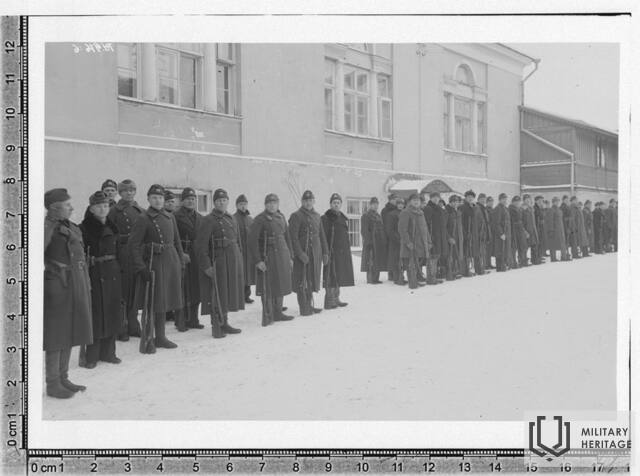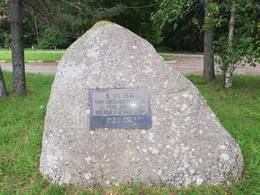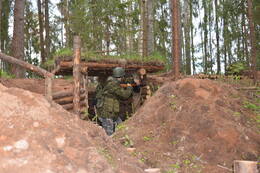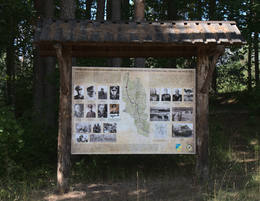Savigyna II WW2
Omakaitse (vok. „Home Guard“, vokiškai „Selbstschutz“) buvo vidaus saugumo organizacija Estijoje vokiečių okupacijos metais 1941–1944 m.
1941 m. birželio mėn. suėjo vieneri metai, kai Estiją žiauriai okupavo Sovietų Sąjunga, atnešusi areštų, trėmimų ir sovietizacijos bangą. Pirmosiomis Sovietų Sąjungos invazijos savaitėmis matydami greitai artėjančias vokiečių pajėgas, tūkstančiai estų slapstėsi miškuose kaip vadinamieji miško broliai, kad išvengtų Raudonosios armijos pašaukimo ir pakenktų sovietų valdžiai. Per laikinąjį valdžios vakuumą po bolševikų atsitraukimo ir prieš atvykstant vokiečių pajėgoms, daugelis Estijos vyriausybės subjektų buvo atkurti ir buvo padėti sukurti teisėsaugos struktūrą, vėliau pavadintą Omakaitse. Vidaus saugumo organizacijai, kurią daugiausia sudaro buvę Gynybos lygos nariai, buvo pavesta kovoti su naikinimo batalionais ir Raudonosios armijos likučiais bei užtikrinti įstatymų vykdymą. Asmenys, įtariami bendradarbiavus su sovietų valdžia, buvo suimti, o kai kurie net nužudyti pagal minios įstatymus. Vokietijos valdžia pasitelkė „Omakaitse“ narius, kad įgyvendintų savo antisemitinio naikinimo politiką.
Vokiečių pajėgoms okupavus Estiją, Vokietijos karinė valdžia išformavo „Omakaitse“, o miško broliai, dalyvavę 1941 m. vasaros kare, buvo atleisti, tačiau netrukus organizaciją atnaujino Vokietijos armijos grupės Šiaurės vadas Vilhelmas Ritteris von Leebas, vadovaujamas Estijos „Hilfschaftz-Administration“ teisėsaugos. Omakaitse buvo pavaldi Vokietijos karinėms ir policijos organizacijoms. „Omakaitse“ sudarė savanorius milicininkus iki 1943 m. spalio mėn., kai tai buvo privaloma visiems vyrams, kurie neatitiko mobilizacijos reikalavimų.
„Omakaitse“ buvo pavesta palaikyti vidaus saugumą ir vykdė policijos ir nacionalinės apsaugos pareigas, įskaitant geležinkelių ir greitkelių apsaugą bei sovietų desantininkų atgrasymą, įvairių vietų stebėjimą, pabėgusių karo belaisvių sekimą, pakrančių gynybą ir pan.
Susijusios vietos
Timmkanalo mūšio vieta
1941 m. liepos 4 d. „Miško broliai“ užpuolė vykdomąjį komitetą Hedemeeste. Grupei vadovavo Elmaras Toomingas, Metsapoole pradinės mokyklos direktorius ir Gynybos lygos Hedemeeste regioninio padalinio vadovas.
Liepos 6 d. atvyko Raudonosios armijos naikinimo batalionas: kai kurie jų žuvo, kiti buvo paimti į nelaisvę.
Liepos 7 d. jungtinės 400 Raudonosios armijos pėstininkų ir naikinimo batalionų pajėgos užpuolė vietos miliciją, kurią sudarė 60 vyrų. Gynėjai, padedami dviejų lengvųjų tankų, buvo nustumti į Timmkanalą, kur reorganizavosi ir vėl užėmė pozicijas.
Liepos 8 d. naikinimo batalionas sudegino 14 sodybų ir mokyklą Rannametsa kaime bei bažnyčią Võistėje. Tahkurannoje įvyko mūšis tarp žygiuojančių vokiečių ir iš Rannametsa paliekančio naikinimo bataliono, kuris neteko 57 vyrų, o aštuoni buvo paimti į nelaisvę. Kai kurie šaltiniai teigia, kad vokiečių dalinys buvo 402-asis dviratininkų batalionas, vadovaujamas majoro Ullerspergerio. Estijos ir vokiečių daliniai tą pačią popietę atvyko į Pernu. Mūšio vietą žymi granito riedulys, papuoštas juoda lentele su užrašu: „1941 m. liepos 8 d. Pernu naikinimo batalionas sudegino 18 namų ūkių ir mokyklą Rannametsa kaime“. Po teksto pateikiama Hando Runnelio eilėraščio citata.
Gynybinė linija „Walk“
Valgos gynybos linija (Pėsčiųjų takas) buvo nutiesta palei Väike Emajõe-Koiva upės liniją 1944 m. birželio pradžioje. Šiaurinė linijos dalis baigėsi prie Vertsjervo ežero ir driekėsi nuo Pikasilos beveik iki pat Ligaste dvaro, esančio kairiajame Väike Emajõgi upės krante. Gynybos liniją sudarė dvi gynybos juostos, kartais siekiančios 10–12 kilometrų gylį. Fronto linija buvo aptverta spygliuota viela ir minų laukais. Visi tiltai ant Väike Emajõgi ir Koivos upių buvo sunaikinti (nors Pikasilos ir Jõgeveste tiltai buvo sunaikinti tik rugpjūčio 26 d. vidurdienį), o visi tiltai už gynybos linijos buvo paruošti sunaikinimui. Antroji linija ėjo palei Õhne ir Pedeli upes, o gynybiniai statiniai apėmė Tervos ir Valgos miestus, kurie buvo pertvarkyti į pasipriešinimo punktus.
Pagrindinę gynybos liniją sudarė du apkasų rinkiniai, svarbiausiuose ruožuose net trys ar keturi gerai išvystytų apkasų rinkiniai su jungiamosiomis sistemomis. Gynybos linijai tiesti vokiečiai pasitelkė rusų karo belaisvius ir jėga verbavo vietos gyventojus organizacijos „Todt“ sudėtyje.
Šioje vietoje atkurti apkasai ir gaisrinės. Šioje teritorijoje įsikūręs Valgos karinis pramogų parkas, kuris vadovavo pastangoms atkurti kalvos karo laikų išvaizdą. Lauko erdvė atidaryta 2015 m.; Valgos karinis pramogų parkas reguliariai organizuoja lazerinių ginklų mūšius ir kitus renginius.
Apkasai ir stulpai buvo atkurti buvusiose vokiečių įtvirtintose pozicijose. Teritoriją valdo Valgos karinis pramogų parkas, kuris vadovavo restauravimo darbams, siekiant atgaivinti kalvagūbrio karo laikų išvaizdą. Lauko zona, kurioje dabar vyksta lazerinio šaudymo ir specialūs renginiai, buvo atidaryta 2015 m.
Greitas tilto mūšio laukas
Tai yra gynybos linijos „Pėsčiųjų takas“ dalis. Valgos gynybos linija (Pėsčiųjų takas) buvo nutiesta palei Maže Emajõe-Koiva upės liniją 1944 m. birželio pradžioje. Šiaurinė linijos dalis baigėsi prie Vertsjervo ežero ir driekėsi nuo Pikasilos beveik iki pat Ligaste dvaro, esančio kairiajame Maže Emajõgi upės krante. Gynybos liniją sudarė dvi gynybos juostos, kartais siekiančios 10–12 kilometrų gylį. Fronto linija buvo aptverta spygliuota viela ir minų laukais. Visi tiltai ant Maže Emajõgi ir Koivos upių buvo sunaikinti (nors Pikasilos ir Jõgeveste tiltai buvo sunaikinti tik rugpjūčio 26 d. vidurdienį), o visi tiltai už gynybos linijos buvo paruošti sunaikinimui.
Raudonoji armija planavo likviduoti Narvos fronte dislokuotas vokiečių ir estų pajėgas, atakuojant per Tartu iš jų užnugario. Įgyvendindama šį planą, Raudonosios armijos 3-iojo Baltijos fronto vadovybė pasiuntė keturis dalinius į Emajegio liniją. Jų užduotis buvo kirsti Emajegio upę ir, judant ratu per šiaurinį Vertsjervo ežero krantą, su Vokietijos 18-ąja armija, dislokuota Narvos fronte, užimti Šiaurės Estiją. Jie taip pat planavo palaužti vokiečių pasipriešinimą Pikasilos-Valgos linijoje ir atkirsti vokiečių atsitraukimo kelią Rygos link.
Pietų Estijoje gynybą sudarė šešios Vermachto XXVIII ir XXXVIII armijų korpusų divizijos ir mažesni daliniai, o užnugarį gynė 207-oji pastiprinimo divizija. Operacijos pradžioje Raudonoji armija turėjo kiekybinį pranašumą gyvosios jėgos ir kovinės įrangos atžvilgiu. Vokiečių pajėgas daugiausia sudarė įvairios kovinės grupės ir mažesni daliniai. Gynyboje dalyvavę „Omakaitse“ daliniai buvo prastai aprūpinti ir turėjo žemą kovinę moralę.
Rugpjūčio 27 d. Raudonajai armijai pavyko kirsti Mažąją Emajegio upę ties Pikasila ir ten išlaikyti nedidelį tiltą. Iki rugsėjo 13 d. vokiečių ir estų „Omakaitse“ divizijai pavyko sustabdyti artėjančius Raudonosios armijos dalinius gynybos linijoje „Walk“. Rugsėjo 14 d. 3-iojo Raudonosios armijos Baltijos fronto divizijos pradėjo puolimą ir rugsėjo 17 d. pralaužė gynybos liniją.








